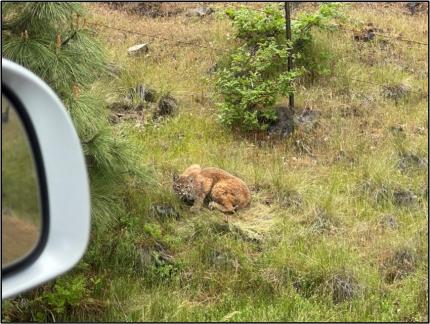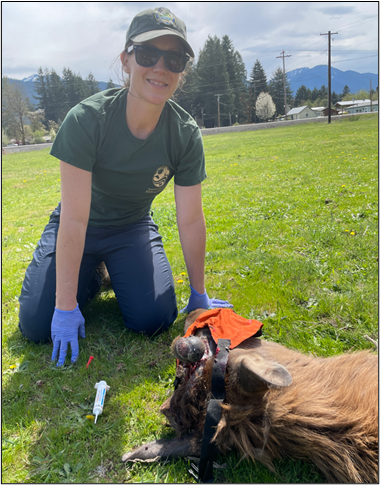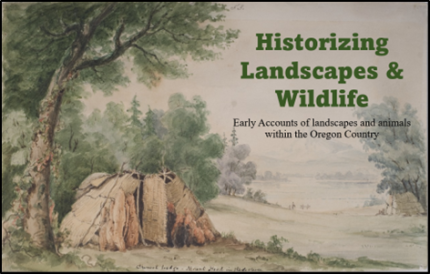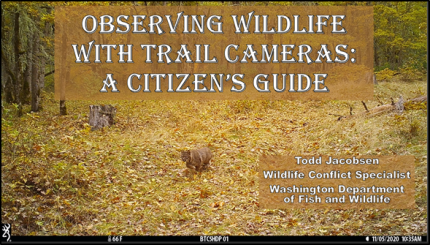Managing Wildlife Populations
Banding Pigeons: In a game of Hurry Up and Wait, Wildlife Area Manager Hauswald and Assistant Manager Risley banded eight band-tailed pigeons near Woodland, Washington. The Pacific Coast band-tailed pigeon is managed as a migratory game bird in Washington. Its population is low for several reasons, but habitat loss is a significant contributing factor. Relocation of these banded pigeons may help Washington Department of Fish and Wildlife (WDFW) biologists identify important locations that can be added to a growing list of sites for monitoring along coastal and interior portions of Washington. Relocation data can also be used to learn more about migration timing, as well as winter use areas.


Annual Mule Deer Meeting: Biologists Bergh and Wickhem attended the annual meeting for WDFW staff members who manage mule deer. The group discussed survey methodology and potential improvements, data management and improvements, disease, migration research, and habitat work.
Providing Conflict Prevention and Education
Black Bear Damage: Wildlife Conflict Specialist Jacobsen received multiple reports of a black bear breaking into sheds and chicken coops in a western Skamania County neighborhood. The bear recently consumed eight chickens in one coop. Jacobsen and Conflict Technician Kolenberg conducted a site visit to examine the damage and to determine what actions were necessary. Based on the nature of the incidents and time of year, Jacobsen decided to set a trap for the bear. Jacobsen and Kolenberg provided advice on securing attractants and electrifying chicken coops to the landowner. Trail camera surveillance and an empty trap indicated that the bear had not been back to the area over the following week, and the trap was pulled from the residence. Jacobsen received a report the next week of the bear raiding garbage cans, on garbage collection day, roughly one mile away. Jacobsen and Kolenberg will continue to monitor the situation and respond to any additional reports that come in from this area.


Raccoon Assistance: Wildlife Conflict Specialist Jacobsen responded to a nearby residence in Klickitat County where a raccoon was caught in a live animal trap. The homeowner was attempting to catch feral cats but accidentally caught a raccoon instead. The elderly homeowner was not familiar with handling wildlife and, due to her concern of being bitten, requested WDFW’s assistance to release the raccoon. Jacobsen arrived at the residence and demonstrated to the homeowner how to release the raccoon from the trap so that she could do it herself in the future should the situation arise again. The homeowner, as well as the distraught raccoon, was very appreciative of the assistance.

Bear Complaint: Wildlife Conflict Specialist Jacobsen provided advice over the phone to a landowner who was watching a black bear in her yard from her house window. The landowner was concerned about the bear presence in the area. The landowner was able to successfully scare the bear away with a siren sound on her phone. After discussing the incident with the landowner, Jacobsen found out that the bear had previously discovered bird feeders at the residence and had helped itself to the bounty. The landowner had since secured her attractants, but the bear apparently came back to see if bird food was on the menu that day.

Injured Bobcat: A motorist was driving through Klickitat County when she observed an injured bobcat along the side of the road near a popular hiking trail. She contacted Wildlife Conflict Specialist Jacobsen, who happened to be 15 minutes away at the time of the report. Jacobsen responded to the scene. Despite the fact that the bobcat didn’t even try to move when the motorist photographed it a short while earlier, it was no longer at the scene when Jacobsen arrived. Jacobsen searched on foot but was unsuccessful. Given the proximity to the popular hiking trail, which is advertised as a dog-friendly trail and is heavily used by two and four-legged recreationists, Jacobsen requested a local houndsman assist in locating the bobcat in the hopes that it could be immobilized, captured, and transferred to a rehabilitation clinic. Unfortunately, or fortunately, the houndsman was not able to locate the bobcat either, which likely means the bobcat was still fairly mobile and likely to recover from its injuries.

Injured Bald Eagle: Wildlife Conflict Specialist Jacobsen received a phone call from a concerned citizen who had found an injured bald eagle. The eagle was in a grassy field at Beacon Rock State Park. Jacobsen responded to the location with Ranger Yeats and the reporting party. Jacobsen was able to successfully capture the eagle and transfer it to the Rowena Wildlife Clinic where its condition was assessed. The eagle turned out to be slightly emaciated and had an injury under one of its wings. It is now receiving treatment and is recovering at the rehabilitation clinic in Oregon.

Capture and Release of Elk with Portions of a Hammock Entangled in His Antlers: Biologists Stephens and Holman teamed up to capture an elk with portions of a hammock entangled in his antlers. The subject elk spends most of his time within the city limits of Packwood and first became entangled with the hammock in October 2022. At that time, Conflict Specialist Aubrey evaluated the elk and discussed its situation with district wildlife biologists. Consensus at that time was that since the animal could eat, move, and drink and because it was post-rut, the elk would both survive and be unlikely to become entangled with another bull. Furthermore, the situation would likely resolve itself without WDFW intervention when the bull shed his antlers during the following spring.
The elk subsequently survived several months. During that time, the elk generated a lot of interest among the citizens of eastern Lewis County. Media coverage including Tacoma and Centralia newspapers as well as Seattle’s King 5 News all ran stories on the elk. Thanks to Conflict Specialist Aubrey for fielding the many public contacts regarding this animal.
On approximately April 23, the bull shed his antlers but failed to free himself from the entangling material. District 10 staff members discussed the situation again and decided that a capture attempt was warranted. On May 2, Biologists Stephens and Holman successfully captured the elk, removed the entangled material, treated the underlying tissue for infection, and released the elk on site.
WDFW posted the story on Facebook.



Conserving Natural Landscapes
Planting Peas for Wildlife: Wildlife Area Manager Hauswald and Assistant Manager Risley planted an estimated eight acres of peas at the Shillapoo Wildlife Area. Peas are popular with migrating waterfowl in the fall and winter months, specifically Canada and snow geese. Once the peas have grown, matured, and dried, the peas are then “shattered” making them an attractive and accessible snack for the migrators.

Removing Garbage from Access Program Land in Klickitat County: Private Lands Biologist Gray visited one of the WDFW Private Lands Access Program sites popular during the wild turkey hunting season to engage with hunters and get feedback on the program. While there, Gray stopped to drag large pieces of metal trash off the property and hauled them to the dump station to keep the property maintained.

Providing Education and Outreach
Program Presentation in Cowlitz County: Private Lands Biologist Gray attended the combined annual meeting of the Cowlitz Farm and Forestry Association and the Cowlitz Conservation District as a speaker at the event. She gave a presentation about the WDFW Private Lands Access Program to an audience of 50 farmland and small forest landowners regarding how the program could help fit the goals of their land.

Bear and Cougar Mailers: Every year, Wildlife Conflict Specialist Jacobsen maps bear and cougar complaints throughout District 9 to help determine priority areas for education and outreach efforts. Last year, the White Salmon area was a source of abundant bear complaints. This spring, Jacobsen sent out a targeted bear/cougar mailer to the region. Thanks to tremendous help of the Region 5 Customer Service team and Conflict Technician Kolenberg in preparing the mailers. The mailer effort was able to reach over 3,400 residents of the greater White Salmon area. Hopefully these efforts will lead to reduced bear and cougar conflicts in the future!


Wild About Nature 10 Series: Wildlife Conflict Specialist Jacobsen and Conflict Technician Kolenberg delivered presentations at the 10th annual Wild About Nature speaker series in White Salmon. Conflict Technician Kolenberg’s presentation focused on historic wildlife and landscape accounts of the Columbia River Gorge area pre-European settlement. Jacobsen’s presentation focused on observing wildlife with trail cameras. Roughly 55 members of the public were in attendance and the presentations were well received.








Conducting Business Operations and Policy
Immobilization Certification Course: Several Wildlife Program staff members from Region 5 attended WDFW Wildlife Immobilization and Capture courses held in Olympia and Ellensburg this week. This course is required for wildlife staff members every five years.